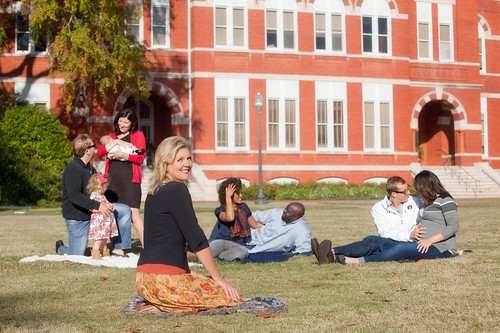How to maintain healthy relationships during quarantine, social distancing
Article body
Professor Francesca Adler-Baeder, a veteran researcher on marriage and relationships, shares her expertise on how couples and families can keep relationships healthy in the era of quarantine and social distancing due to COVID-19.
How does the current situation, in which people are encouraged to practice social distancing, relate to your research?
My work centers on our human need for healthy social connection and support—and ways to promote relationship quality and stability through community programming for couples. We know from decades of research that our physical health, mental health and our relational health are inextricably linked. Because of this, I think it is vital that we understand that the current recommendations actually are promoting “physical distancing” to slow and reduce the spread of COVID-19. “Social distancing” may not be the best term to use since it is critical that we remain socially connected and not feel isolated.
Stress is inevitable in daily living and healthy couple relationships have to be fostered in the context of stress. Certainly, the current situation is unprecedented in our lifetime and everyone is experiencing multiple layers of stress. Focusing on ways to manage our couple and family relationships will have important implications for how well we fare in all aspects of our health and well-being over the months ahead.
How will social distancing affect couples who are not living under the same roof?
Those who are already accustomed to managing their relationships long-distance, typically because of work requirements, will have an advantage in this situation. The key in these situations is maintaining social and emotional connection on a daily basis. Healthy couples are engaged with each other in supportive ways in small, frequent doses. Most utilize various apps and messaging for communicating. To reduce feelings of isolation, video calling can be especially helpful. At a minimum, it can be helpful to plan for morning check-in calls and evening “de-brief” calls. These are opportunities to stay tuned-in to what each partner is facing—and what they dealt with—that day. There can be practical elements to these conversations, but it is vital that a focus be on emotional support—“cheerleading” for each other.
This situation also likely affects our students who are in couple relationships and who went home for spring break and are now apart from their significant other. This unexpected physical separation is most likely to cause distress since it is out of the norm for these couples. It is important for families to ask about and provide support and empathy to their college student who may be dealing with sadness and loneliness from the physical separation from friends and partners.
For the couples who are socially distancing in the same household, what are the benefits of more time together at home?
Despite the challenges, there definitely can be some benefits for couples living together. As long as there is no need to quarantine a family member apart from the rest of the family, couples can benefit from some additional time they may not typically have. Prior to this situation, busy families often reported limited time that they actually overlapped in the household and couples reported most often communicating about practical tasks. With a slow-down in schedules and more physical togetherness, couples have time for deeper conversations, exercising together, taking walks together, family games and family meal-times. Research indicates these moments can have positive effects on relationships and promote intimacy.
What kind of unique challenges might they face during this time?
Each family situation is so different. Some couples have multiple, layered challenges with job loss or reduced hours, no outside child care, may be managing health conditions and may be managing eldercare. Many are adjusting to the blurred lines between family care and remote work. All are managing adjustment to physical separation from friends and family and feelings associated with the uncertainty of the situation.
Importantly, in some families who are at risk for high conflict and abuse, the current situation poses a clear threat to individuals’ and children’s safety.
What are the best ways to overcome those challenges?
First, safety is primary. If you or someone you know is at risk of harm, contact the National Domestic Violence Hotline. Their latest message: “Given the spread of #COVID_19, we’ve taken steps to keep our staff safe. We’re still here 24/7, but there may be longer than usual wait times. Call 1-800-799-7233, or if you’re unable to speak safely, you can log onto http://thehotline.org or text LOVEIS to 22522.”
Secondly, if basic needs for food, housing and health care are a concern, connect with the resources available in your community. Contact a local family resource center or your local county Extension office (www.aces.edu). They will have information on available programs and resources.
For couples working to navigate these new circumstances there are several key strategies for best ensuring we come through this with relationships intact—and even enhanced.
-
Self-care. In our community-based couple relationship classes that we offer throughout Alabama, we always begin with an emphasis on each partner’s self-care practices. When you are taking care of yourself—eating healthy, exercising, engaging in a contemplative or mindful practice—you are working on your couple relationship. Individuals who pay attention to their own self-care are naturally better at respectful conflict management and are more supportive and empathic with their partners and children.
-
Discuss together your new routines, responsibilities and rules. If you have children, first discuss as a couple and then come together as a family to discuss. Emphasize equity, and work to ensure mutual agreement and shared expectations. Agree to reassess periodically.
-
Balance togetherness and privacy. While there can be some benefits to this additional facetime in families, there can be challenges as well. Healthy couples create a sense of “we-ness” but also have aspects of their lives that are separate and distinct. Ask for and be respectful of others’ needs for alone time. This includes children’s needs, particularly adult children, who may have returned home. If space is limited in the home, remember that physical distance protocols still allow for—and encourage—outdoor activities.
-
Practice empathy. Everyone’s reaction to this situation will be uniquely theirs. Take time to ask questions of each other about how you are feeling. Ask your children. Problem-solving is not really the goal. Human needs are really more about feeling heard and validated.
-
Practice forgiveness and soothing. The many changes occurring in families and the close proximity to each other can create tensions and irritability. Notice when a situation is escalating and work to soothe and calm yourself and your partner. Time-outs are not just effective for children; they work well in couple relationships too. Time-outs should include self-calming practices, like music, physical activity or focusing on the positives in your relationship. Offer and accept forgiveness. It is an important couple relationship skill.
-
Engage in service. Research shows that couples who volunteer and engage in their communities have healthier relationships. While engagement and service may look different now, seek out ways that you and your family can serve and help others. A simple search of “community service opportunities” will bring up a long list of possibilities in your community. Most have adjusted offerings to include ways to help remotely and many are not resource-dependent, meaning, that regardless of your income, there are ways to make meaningful contributions, especially during this time. “Other-orientation” can help ease the personal stress we feel.
Are there any online resources you suggest people use during this time?
Many in our field are actively working to provide online, research-based resources addressing the current situation. In the meantime, many general resources that could be helpful are currently available.
-
The Alabama Healthy Marriage Handbook (in English and Spanish): http://www.alabamamarriage.org/marriage-handbook.php
-
Our project website is http://www.alabamamarriage.org/
We are transitioning to online delivery of couples education through Zoom. Contact Leah Burke through the “Contact Us” page or directly at lka0001@auburn.edu to find out more and to register.
-
A training program designed through a multi-state faculty collaborative is available online and contains a library of informative fact sheets that are useful for couples: https://www.fcs.uga.edu/nermen/nermen-resources-hrmet-modules
-
The University of Wisconsin-Madison is making its mindfulness app available for free at this time: https://tryhealthyminds.org/
-
The Gottman Institute has a free app of conversation “cards” based on couples research that validates the importance of shared meaning and intimate knowledge between partners. Download at: https://www.gottman.com/couples/apps/
-
One of our Auburn alumnae, Dr. Cassandra Bolar, is a marriage and family therapist and professor. Her “Uplifting Relationships” website has many resources: https://www.upliftingrelationships.org/drcassandra
Auburn University is a nationally ranked land grant institution recognized for its commitment to world-class scholarship, interdisciplinary research with an elite, top-tier Carnegie R1 classification, life-changing outreach with Carnegie’s Community Engagement designation and an undergraduate education experience second to none. Auburn is home to more than 30,000 students, and its faculty and research partners collaborate to develop and deliver meaningful scholarship, science and technology-based advancements that meet pressing regional, national and global needs. Auburn’s commitment to active student engagement, professional success and public/private partnership drives a growing reputation for outreach and extension that delivers broad economic, health and societal impact.







